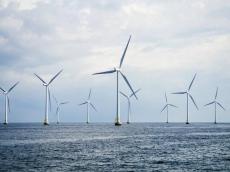|
|
TODAY.AZ / Business
Offshore Wind Roadmap for Azerbaijan released
03 June 2022 [17:50] - TODAY.AZ

By Trend
A new roadmap released today by the Ministry of Energy of the Republic of Azerbaijan, the World Bank and the International Finance Corporation (IFC) shows that Azerbaijan has the potential to install 7GW of offshore wind power by 2040, with the right long-term vision, infrastructure development, investment, and policies - which could play an important role in achieving the country’s parallel priorities of decarbonization and sustainable growth, Trend reports with reference to IFC.
Reportedly, the first-of-its-kind Offshore Wind Roadmap for Azerbaijan provides strategic vision under two scenarios – a low growth and high growth scenario - to support decision-making about regulations, frameworks, and infrastructure related to this new industry at a time when interest in developing offshore wind is increasing globally.
Analysis of the low growth scenario envisions a moderate expansion of offshore wind resulting in 1.5GW of fixed foundation offshore wind by 2040, making up 7 percent of the country’s electricity supply under a decarbonization scenario. The high growth scenario outlines a more ambitious expansion with 7.2GW of offshore wind by 2040, making up 37 percent of its electricity supply.
The high growth scenario will result in more energy, more jobs, faster pay-back and more carbon dioxide avoided compared to the low growth scenario due to the increased cost reduction delivered by a larger market. However, significant and early action needs to be taken for this to happen. Both scenarios would only be tapping into a fraction of the vast technical potential for offshore wind resource in the country.
The roadmap sets out the recommended actions to be taken in order to realize the offshore wind potential under both scenarios. These recommendations include setting targets for 2030 and 2036, developing and competitively bidding a 200MW demonstration project followed by larger projects, further exploring potential offshore wind development zones, modernizing infrastructure, adopting international best practices to attract financing, educating all government agencies and the future workforce to build the knowledge and capacity needed to deliver a pipeline of offshore wind projects.
URL: http://www.today.az/news/business/221158.html
 Print version
Print version
Connect with us. Get latest news and updates.
See Also
- 26 January 2025 [10:00]
Azerbaijan's gas can supply Ukraine and Europe, says Zelensky - 26 January 2025 [09:00]
Azerbaijan sees significant increase in international air cargo transportation in 2024 - 24 January 2025 [15:43]
Baku to host 71st UN Tourism Regional Commission session - 24 January 2025 [14:38]
bp to build new platform on Shah Deniz field - 24 January 2025 [12:27]
SOCAR explores cooperation with Oliver Wyman Group on energy innovation - 24 January 2025 [11:43]
Azerbaijan advances risk management to combat financial crime - 23 January 2025 [15:14]
Azerbaijan involves 13,000 people with disabilities in employment programs - 23 January 2025 [13:38]
Azerbaijan holds hybrid meeting on green energy strategy implementation - 23 January 2025 [12:38]
Azerbaijan to increase minimum pension starting February - 23 January 2025 [11:26]
Baku, Tehran sign strategic cooperation plan for Astara Terminal
Most Popular
 Multi-vector approach from Pashinyan: Give as many as you can!
Multi-vector approach from Pashinyan: Give as many as you can!
 US' new Secretary of State reaffirms Türkiye ties and discusses regional issues with Fidan
US' new Secretary of State reaffirms Türkiye ties and discusses regional issues with Fidan
 Ankara, Bratislava forge stronger ties with new strategic partnership
Ankara, Bratislava forge stronger ties with new strategic partnership
 Baku to host 71st UN Tourism Regional Commission session
Baku to host 71st UN Tourism Regional Commission session
 Kazakhstan decides on applicants for construction of first nuclear power plant
Kazakhstan decides on applicants for construction of first nuclear power plant
 Robotic sea turtle ready to explore oceans
Robotic sea turtle ready to explore oceans
 Best of the best choose Azerbaijan: What did Davos show?
Best of the best choose Azerbaijan: What did Davos show?
